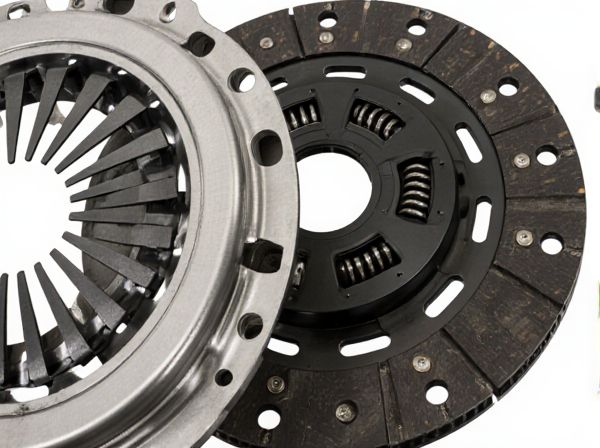
Photo illustration: Cone Clutch vs Diaphragm Clutch
Cone clutches provide precise engagement through a conical friction surface, offering reliable torque transmission ideal for low to medium power applications. Diaphragm clutches use a flexible diaphragm spring to achieve smoother operation and easier pedal effort, making them preferred in modern vehicles for enhanced driver comfort. Choosing the right clutch depends on your vehicle's power requirements and desired driving experience.
Table of Comparison
| Feature | Cone Clutch | Diaphragm Clutch |
|---|---|---|
| Design | Tapered friction surface (cone shaped) | Single diaphragm spring plate |
| Engagement | Smooth but requires precise alignment | Consistent and easier pedal feel |
| Durability | Prone to wear due to friction surface | Longer lifespan with less maintenance |
| Force Distribution | Force applied on cone surface | Even force via diaphragm spring |
| Size & Weight | Bulkier and heavier | Compact and lightweight |
| Applications | Older vehicles, heavy-duty machinery | Modern cars, performance vehicles |
| Cost | Generally lower cost | Higher manufacturing cost |
Introduction to Cone Clutch and Diaphragm Clutch
Cone clutches transmit torque through a conical friction surface, offering high torque capacity in a compact design ideal for automotive and industrial applications. Diaphragm clutches utilize a diaphragm spring to engage and disengage the clutch, providing consistent pressure distribution, longer lifespan, and smoother operation in modern vehicles. Both types optimize power transmission but differ in mechanism, maintenance, and application suitability.
Design and Construction Differences
Cone clutches feature a conical friction surface that mates with a corresponding cone-shaped counterpart, allowing torque transmission through axial engagement and disengagement. Diaphragm clutches utilize a single, circular diaphragm spring that applies pressure evenly to the clutch disc, providing smoother operation and reduced pedal effort. The cone clutch design involves multiple friction surfaces and mechanical linkage, while the diaphragm clutch relies on a flexing spring mechanism, resulting in differences in durability, maintenance, and performance characteristics.
Working Principle: Cone Clutch vs Diaphragm Clutch
Cone clutch operates by engaging conical friction surfaces, where the male cone fits into the female cone to transmit torque through axial force, creating a wedging action that locks the two parts together. Diaphragm clutch uses a diaphragm spring that applies uniform pressure on the pressure plate when actuated, allowing smooth engagement and disengagement by controlling the clamp load on the friction disc. The key difference lies in the cone clutch's mechanical wedging for torque transfer versus the diaphragm clutch's spring-based pressure distribution for efficient torque control.
Material Selection and Durability
Cone clutches typically use cast iron or steel for friction surfaces, providing high wear resistance and heat dissipation, while diaphragm clutches commonly employ organic or ceramic composites for enhanced durability and smoother engagement. Material selection in cone clutches prioritizes robustness under heavy load conditions, whereas diaphragm clutches focus on longevity and consistent performance in varying thermal environments. The durability of diaphragm clutches often surpasses cone clutches in automotive applications due to superior material fatigue resistance and reduced maintenance requirements.
Efficiency and Power Transmission
Cone clutches offer higher torque transmission efficiency due to their wedging action, which provides a larger frictional surface area and better load distribution compared to diaphragm clutches. Diaphragm clutches deliver smoother engagement and reduced pedal effort, but their power transmission efficiency is slightly lower because of the uniform pressure exerted by the diaphragm spring. Efficiency in cone clutches is often preferred for high-torque applications, while diaphragm clutches excel in passenger vehicles requiring quick and smooth shifts.
Maintenance Requirements and Lifespan
Cone clutches require regular inspection and adjustment due to their multiple friction surfaces, which are prone to wear and contamination, potentially reducing lifespan without proper maintenance. Diaphragm clutches feature a simpler design with a single pressure plate, resulting in lower maintenance needs and a generally longer lifespan under similar operating conditions. Proper lubrication and timely replacement of friction materials are essential for maximizing the durability of both clutch types.
Application Areas in Automotive and Machinery
Cone clutches are commonly used in automotive transmissions and geared machinery where high torque transmission and gradual engagement are required, often found in older vehicle models and heavy-duty equipment. Diaphragm clutches, favored in modern automobiles and agricultural machinery, offer smoother operation and easier adjustment due to their single spring design, enhancing driver comfort and reducing wear. Both clutch types serve critical roles in power transmission, with cone clutches excelling in durability under heavy loads and diaphragm clutches optimizing performance for frequent engagement cycles.
Performance Under Load and Heat
Cone clutches offer high torque transmission with excellent heat dissipation under heavy loads due to their large contact area and friction surface design. Diaphragm clutches provide consistent performance under variable loads by maintaining uniform pressure distribution, which enhances heat resistance and reduces clutch fade. Both clutch types are engineered to withstand thermal stress, but cone clutches typically handle higher thermal loads more effectively in demanding performance applications.
Cost Comparison and Availability
Cone clutches typically have lower manufacturing costs due to simpler design and fewer components, making them more affordable for budget-sensitive applications. Diaphragm clutches, while generally more expensive, offer better durability and consistent performance, which can justify the higher initial investment in high-demand scenarios. Availability of cone clutches is widespread in older or specialized vehicles, whereas diaphragm clutches dominate the modern automotive market due to mass production and standardized replacement parts.
Pros, Cons, and Suitability Recommendations
Cone clutches offer high torque transmission and smooth engagement due to their large friction surface but can suffer from wear and require precision alignment, making them suitable for low to moderate power applications where durability is less critical. Diaphragm clutches provide consistent pedal feel, compact design, and easier maintenance with reduced wear, making them ideal for modern vehicles and high-performance engines that demand reliable, long-lasting engagement. Choosing between cone and diaphragm clutches depends on application-specific factors such as torque requirements, space constraints, and maintenance preferences, with diaphragm clutches often favored for automotive use and cone clutches for industrial machinery.
 caratoz.com
caratoz.com